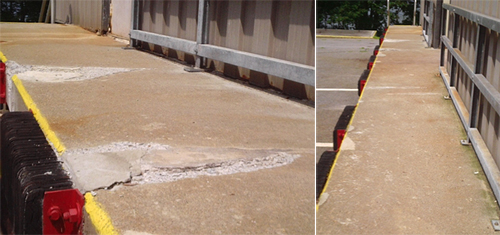Necessary Overview to Budget-friendly Dock Repairs for Homeowners
Necessary Overview to Budget-friendly Dock Repairs for Homeowners
Blog Article
Reliable Dock Repair Service Techniques: Making Sure Structural Honesty
Making sure the structural stability of docks through reliable repair methods is critical for the durability and security of aquatic centers. This involves a multi-faceted method beginning with extensive inspections making use of sophisticated technologies like finder devices and from another location operated lorries (ROVs) to spot both noticeable and concealed problems. Ultimately, selecting the ideal repair work products, such as corrosion-resistant alloys and composite materials, is essential for toughness. Structural reinforcement approaches, consisting of the application of cross-bracing systems and load-distribution plates, play an essential function in mitigating stress and anxiety factors. However, the significance of these strategies becomes noticeable when exploring innovative repair service approaches and preventative maintenance approaches.
Examining Dock Damage
Evaluating dock damage is a critical initial step in guaranteeing the architectural stability and safety and security of any docking center. Secret facets to take a look at consist of the dock's structure, pilings, decking, and equipment (Dock Repairs).
Structural engineers or certified inspectors typically carry out these evaluations making use of specialized devices and techniques. Undersea assessments might utilize sonar devices or remotely operated automobiles (ROVs) to discover immersed damage. Over water, visual examinations are enhanced by utilizing wetness meters and other diagnostic tools to uncover underlying issues not instantly visible to the nude eye.

Choosing Repair Service Products
Picking the suitable repair work materials is a critical action in the dock reconstruction process, one that directly influences the long life and performance of the repaired structure. Material option should be driven by elements such as environmental conditions, load-bearing demands, and compatibility with existing dock parts. For example, timber is a standard choice for anchors because of its all-natural strength and aesthetic allure. Nonetheless, picking the ideal kind of wood, such as pressure-treated lumber or naturally rot-resistant types like cedar or teak wood, is important to hold up against marine settings.
Along with wood, composite products are progressively prominent as a result of their sturdiness and low upkeep requirements. Compounds, typically made from a mix of plastic and wood fibers, provide outstanding resistance to rot, insects, and UV damage. For steel docks, picking corrosion-resistant alloys such as galvanized steel or marine-grade light weight aluminum is vital to prevent corrosion and guarantee structural honesty in saline water conditions.
Epoxy materials and marine-grade sealants are indispensable for fixing fractures and sealing joints, providing a water resistant barrier and improving the dock's overall strength. By diligently choosing top quality materials, dock repairs can achieve durable outcomes, consequently guarding versus future destruction and making sure risk-free, dependable use.
Architectural Support Techniques
Reliable architectural reinforcement strategies are crucial in ensuring the security and long life of dock fixings. This technique is specifically reliable for docks revealed to hefty loads or severe environmental conditions.
Another crucial technique is the application of fiber-reinforced polymers (FRP) These products provide high strength-to-weight ratios and excellent resistance to article source deterioration, making them excellent for strengthening concrete or wooden docks. FRP can be applied in strips or sheets and adhered with epoxy resins to improve structural integrity.
Supporting and anchoring systems likewise play an essential function in structural support. Cross-bracing, using steel or wood light beams, can combat side forces, lowering persuading and motion. Securing systems, such as helical piers or driven stacks, provide a steady structure by transferring tons to deeper, more stable dirt layers.
Finally, the assimilation of load-distribution plates can help disperse weight much more uniformly throughout the dock's surface, reducing local anxiety factors. These methods jointly guarantee that docks stay robust and secure, efficient in enduring the roughness of their functional setting.
Advanced Repair Work Techniques

One more sophisticated method entails underwater welding, which enables repairs to be carried out without the requirement to dewater the area. This method is specifically helpful for addressing architectural problems in submerged dock parts, guaranteeing minimal disruption to operations. Improved welding strategies, coupled with robot systems, provide precision and integrity, consequently prolonging the lifespan of the dock.
Furthermore, cathodic security systems are applied to avoid deterioration in metallic dock structures. By using sacrificial anodes or satisfied existing systems, these methods properly reduce the electrochemical processes that lead to product degeneration.
Last but not least, progressed monitoring technologies, such as architectural wellness tracking (SHM) systems, give real-time information on the problem of dock frameworks. Recommended Reading These systems enable proactive maintenance and prompt interventions, eventually guaranteeing the long-term architectural stability of the dock.
Upkeep and Avoidance
Maintenance and avoidance are fundamental principles that underpin the long life and security of dock structures. Normal evaluations are extremely important, enabling early discovery of deterioration, prospective weaknesses, and ecological effects. A proactive method, including routine checks for corrosion, rot, and architectural shifts, alleviates expensive repair work and extends the dock's operational life.
Precautionary procedures must include applying safety finishes to steel components to defend against corrosion and making use of treated wood to resist decay. Furthermore, guaranteeing appropriate drain and ventilation can avoid water accumulation, which is a typical source of structural degradation. Including top quality materials and sticking to manufacturer guidelines throughout building and construction and repair phases additionally play vital functions in enhancing longevity.

Training personnel in dock upkeep best practices guarantees regular application of preventative actions. Leveraging technological developments, such as drones for inspections and sensors for real-time monitoring, can even more improve maintenance initiatives. By prioritizing upkeep and check my blog prevention, dock proprietors can guarantee structural stability, functional safety and security, and affordable management over the dock's life-span.
Final Thought
Finally, keeping the structural integrity of aquatic centers demands thorough dock repair strategies. Complete evaluations using innovative tools uncover both visible and concealed problems, while the choice of appropriate repair materials boosts resilience. Implementing architectural reinforcement approaches addresses tension factors properly. Advanced repair work strategies, coupled with normal maintenance techniques, make certain the dock continues to be risk-free and operational under diverse ecological conditions. Embracing these strategies significantly extends the life-span and functionality of marine facilities.
Making sure the structural stability of docks via effective repair service techniques is vital for the long life and safety of marine centers.Selecting the suitable fixing products is a pivotal step in the dock reconstruction procedure, one that straight influences the longevity and performance of the repaired structure.Effective architectural reinforcement strategies are vital in making certain the security and durability of dock repair services. By focusing on maintenance and prevention, dock proprietors can make sure structural honesty, operational safety, and affordable administration over the dock's life-span.
In verdict, maintaining the structural integrity of aquatic centers necessitates thorough dock repair work methods.
Report this page